Radial Flow TES
Overview
Acknowledgment: This material is based upon work supported by the U.S. Department of Energy’s Office of Energy Efficiency and Renewable Energy (EERE) under the Solar Energy Technology Office Award Number DE-EE0009384.
All files and additional documentation are available upon request by emailing Ryan Anderson for a OneDrive link.
Radial flow is a new approach to charging and discharging a packed bed for thermal energy storage (TES). Instead of flowing from one end of the vessel to the other, radial flow considers flow to/from the center of the bed toward the wall. This page shows example files for four approaches:
- Radial flow from a central pipe to four receiving pipes with perforations
- Radial flow with an central pipe and outer perforated annulus for flow
- Radial flow in a large vessel without consideration of the perforations
- Radial flow in a large vessel with the bed segmented
Schematics of the four pipe vs. annular designs (cross-sectional view):
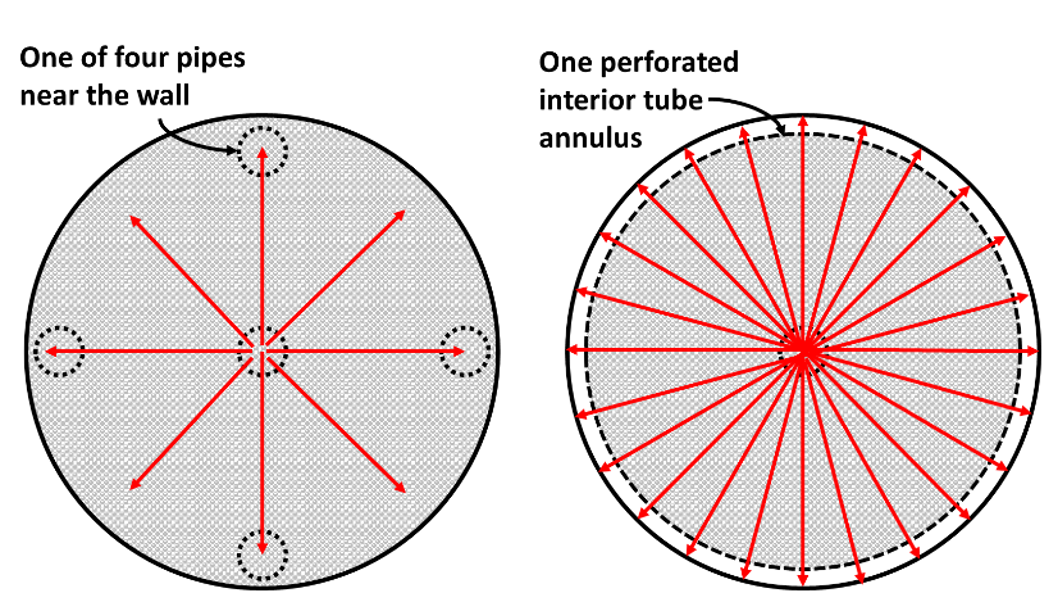
All files and additional documentation are available upon request by emailing Ryan Anderson for a OneDrive link.
Perforated Pipes for Radial Flow TES
Overview: The packed bed domain has a diameter of 12.5 cm and a length of 1 m. Radial flow in this high aspect ratio geometry requires the perforation size to vary along the length of the bed to give even flow. Smaller holes for instance are needed toward the axial end of the bed to provide higher resistance, which stops the flow from bypassing the packed bed. An example of one central pipe and four receiving pipes is shown in the figure. COMSOL files are available upon request for this modeling approach.
Model notes: The model allows one to specify hole sizes, spacings, and rotations throughout the bed. By specifying these parameters, the thousand of perforations can be quickly generated instead of drawing each hole individually. This feature allows the user to quickly modify the design.
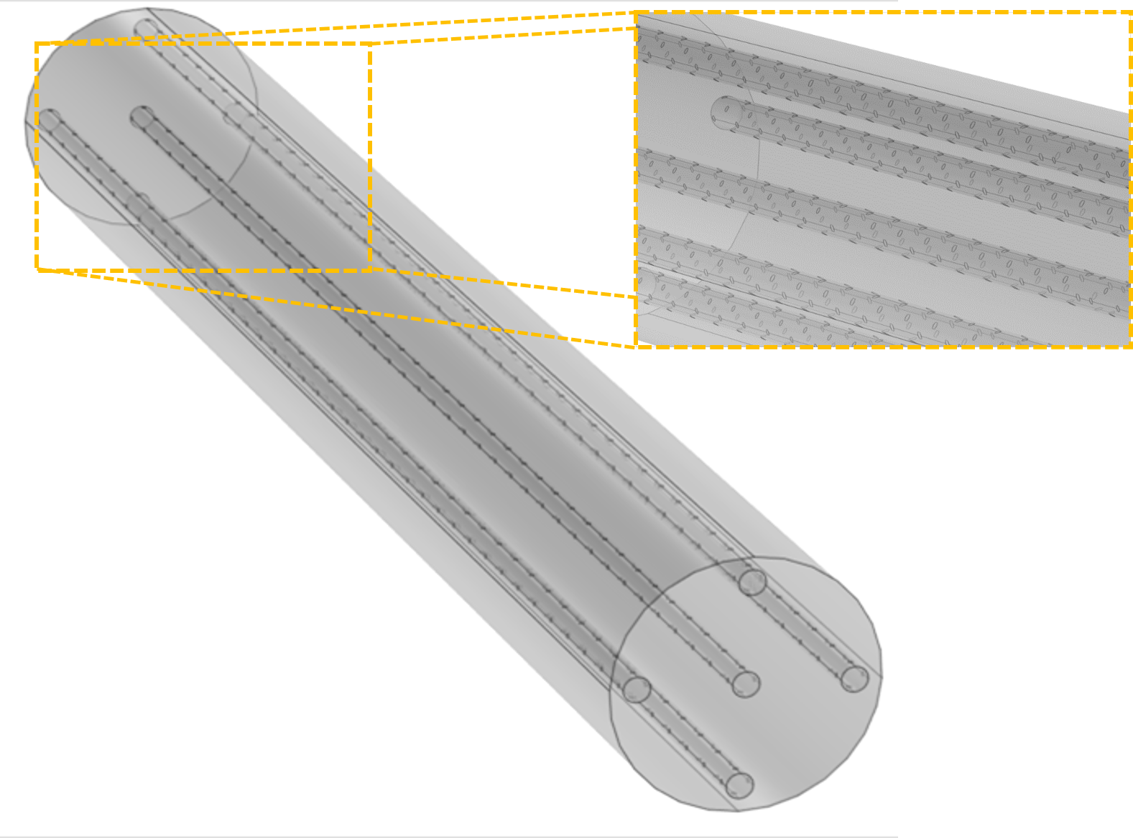
Pros/Cons: This approach does not allow for even flow into the bed considering the location of the four receiving pipes near the walls and the relatively of all domains. Consider the following result for a packed bed for alumina beads with a diameter of 6 mm. flow in this case leads to most flow going directly from the central pipe to the receiving pipe; zones 45 degrees from the receiving pipes receive less flow. This effect occurs regardless of the orientation/alignment of the holes between the central pipe and receiving pipe. An example of preferential flow:

Additional effects are noted, including cases where a) the flow is in the axial direction through the bed and b) where flow reverses direction. The relative resistances and local pressures must be considered if this type of design is ; however, given the preferential flow patterns, this approach is not recommended for radial TES. Annular Piping for Radial Flow TES.
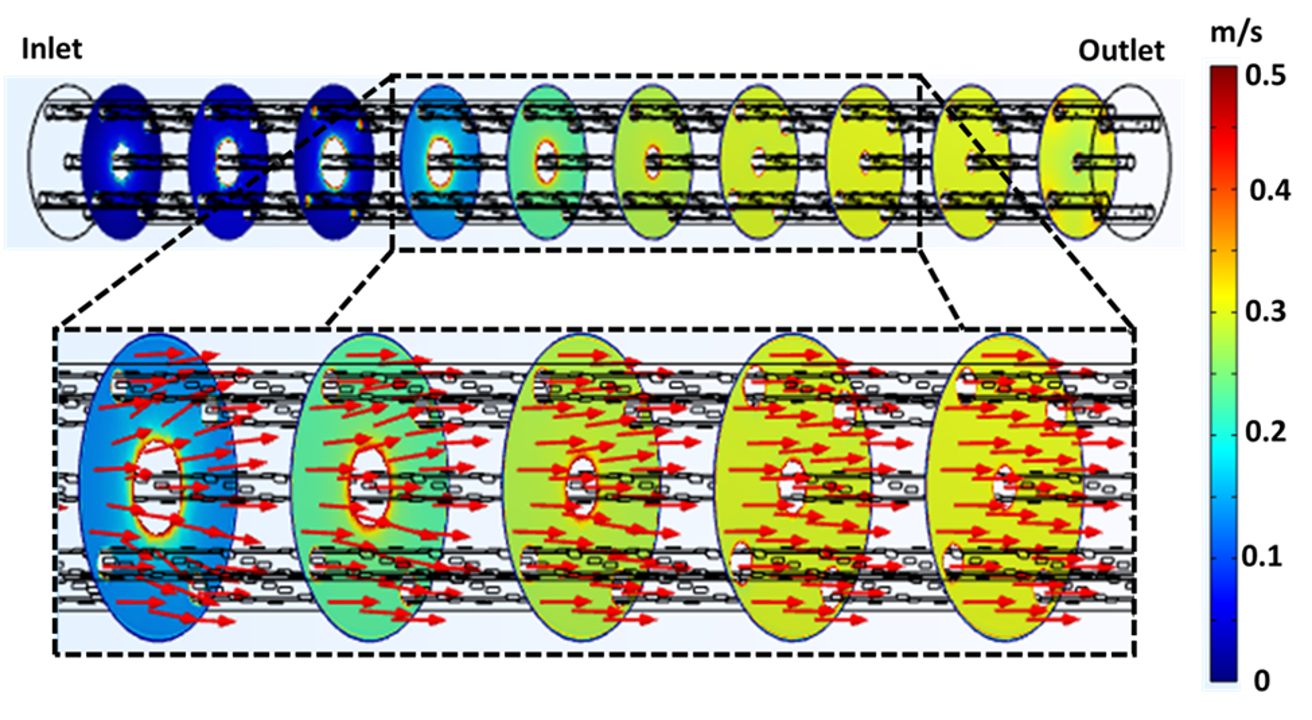
Image from: D. Beck, M. Al-Azawii, P. Bueno, R. Anderson, Enhancing Even Gas Distribution in Porous Media with Radial Flow, American Institute of Aeronautics and Astronautics (AIAA) SciTech Forum, January 3, 2022.
Annular Flow for Radial TES
Overview: This approach involves a central pipe and an annular pipe near the vessel wall. During charging, heated fluid enters the central pipe, exit the perforations, flows through the packed bed, flows through the perforations in the annulus, and flows out of the system through the annular gap between the pipe and vessel well. This flow profile is highlighted schematically above. To model it, a 2D axisymmetric approach was used. In this case, the perforations are thin slits in each pipe (central and annular). Similar to the four-pipe design, one can specify the slit thickness and different slit thicknesses in different parts of the bed. The model then generates the flow and solid domains. COMSOL files are available upon request for this modeling approach.
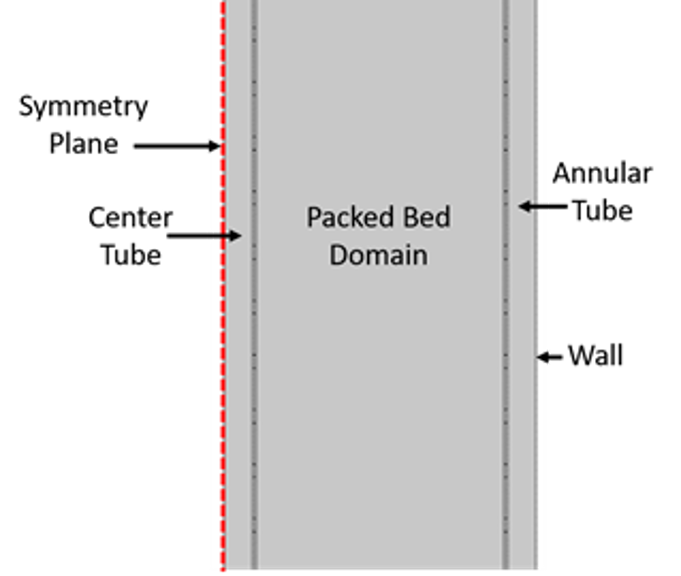
Pros/Cons: This is computationally efficient. It also allows one to consider the material properties of the central and annular pipes, as these may act as heat sinks/conduction zones during charge. In a high aspect ratio vessel like the one utilized in experiments here, the hole sizes still need to be optimized. Uniform flow into the bed is possible. Lowering the pressure drop in the central tube is key, which can be accommodated by a lower overall flow rate or increasing the diameter (for instance). The receiving tube design appears to play a lower role in the overall pressure drop/even flow. A relatively flat profile from experiments is noted below for a charge at 7 SCFM. There still are issues with a heat sink toward the axial inlet (low temp) and preferential flow bypass toward the axial end (higher temp). Note, the two points (o vs. *) represent two thermocouples with eight sensing points each along the axial length of the bed. In ideal radial flow, the temperature would be constant at all locations at a given time. Careful material selection and slit design may mitigate this temperaturemaldistribuiton.
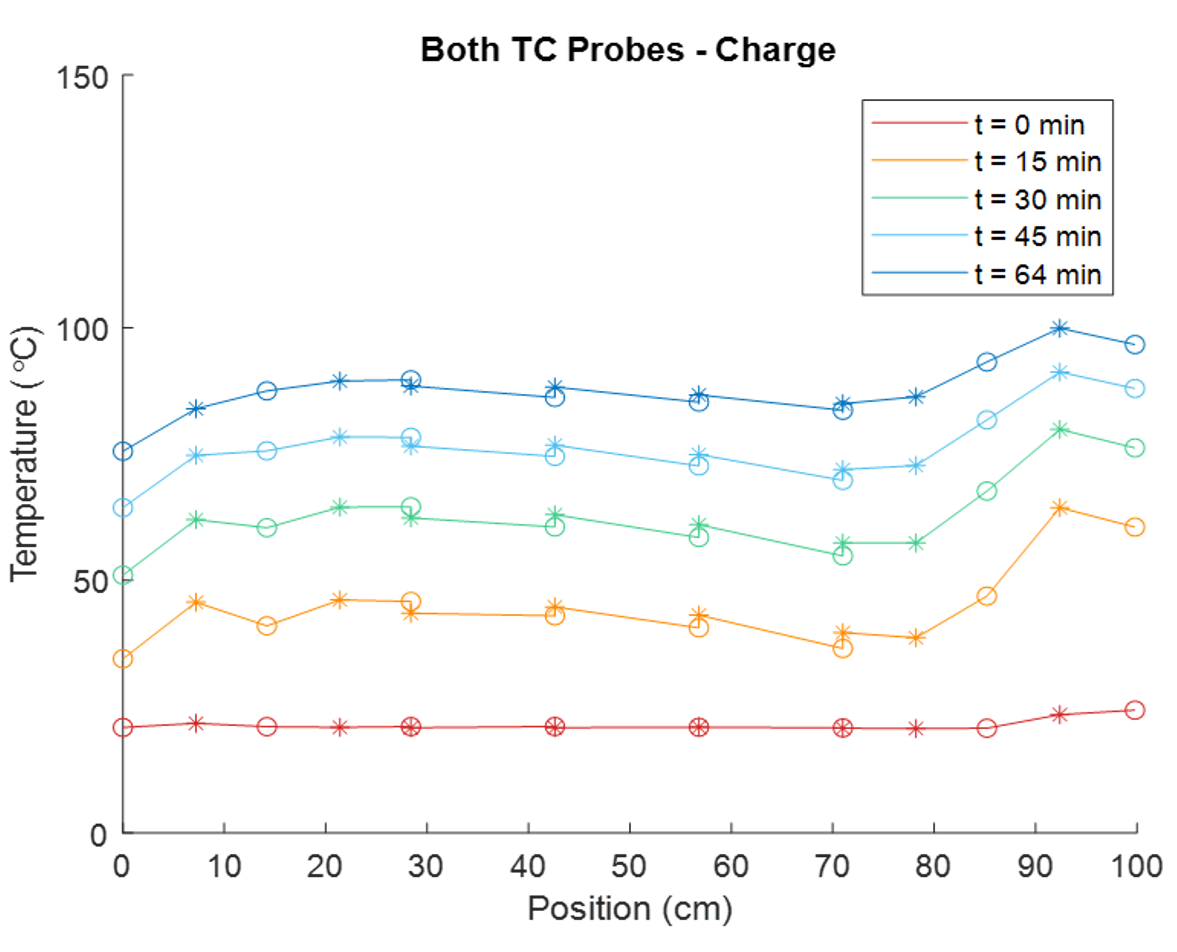
Radial Flow without Discrete Holes, Perforations, or Slits in the Piping
Overview: This approach is more computationally efficient. With a larger center pipe and a larger annular pipe, even flow into the bed can be achieved. The inlet and outlet locations can be switched in the model to run a cycle. Example results for axial vs. radial flow at the same conditions (inlet flow rate, , storage capacity) are shown in the figure during charging. The radial flow setup on the right shows the inlet where the outside of the central pipe would be located.
Pros/Cons: The larger piping system extends the diameter of the bed.
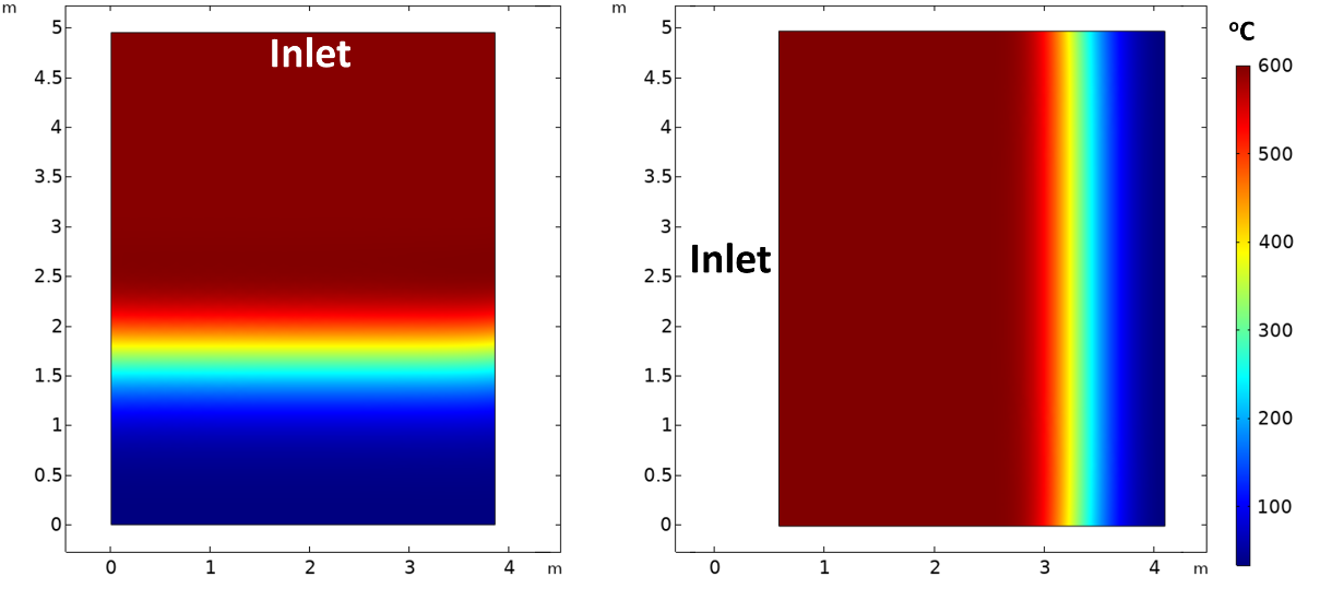
Segmented Radial Flow TES
Overview: The radial bed can be broken into segments for partial charging/discharging scenarios. The results shown in the figure break the packed bed into five segments. Insulation is considered between each segment to limit conduction effects. The results shown here are for a full charge, each at the completion of the fourth segment being charged or discharged.
Pros/Cons: The segments may allow for operational flexibility. However, if the full flow is given to a segment, the pressure drop is high. The thermal front can also spread when flow is not entering a Zone, which can limit efficiency. However, in the case shown here, similar exergetic recovery is noted for these segments compared to the full radial bed.
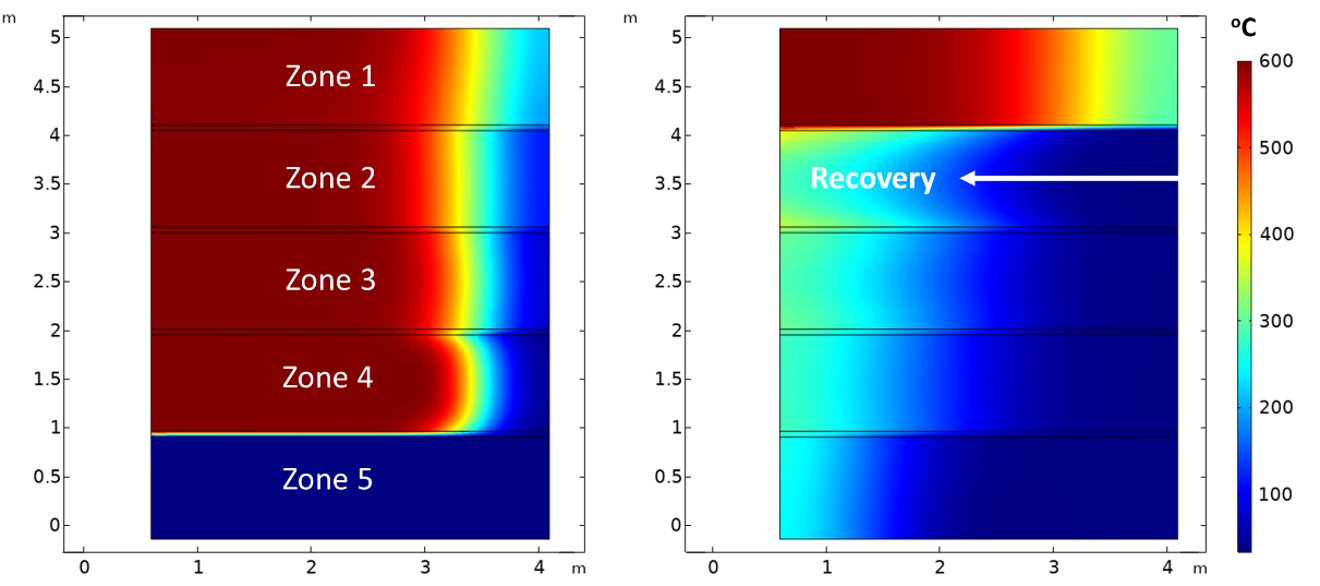
Full Legal Disclaimer
This report was prepared as an account of work sponsored by anagency of the United States Government. Neither the United States Government nor any agency thereof, nor any of their employees, makes any warranty, express or implied, or assumes any legal liability or responsibility for the accuracy, completeness, or usefulness of any information, apparatus, product, or process disclosed, or represents that its use would not infringe privately owned rights. Reference herein to any specific commercial product, process, or service by trade name, trademark, manufacturer, or otherwise does not necessarily constitute or imply its endorsement, recommendation, or favoring by the United States Government or any agency thereof. The views and opinions of authors expressed herein do not necessarily state or reflect those of the United States Government or any agency thereof.
